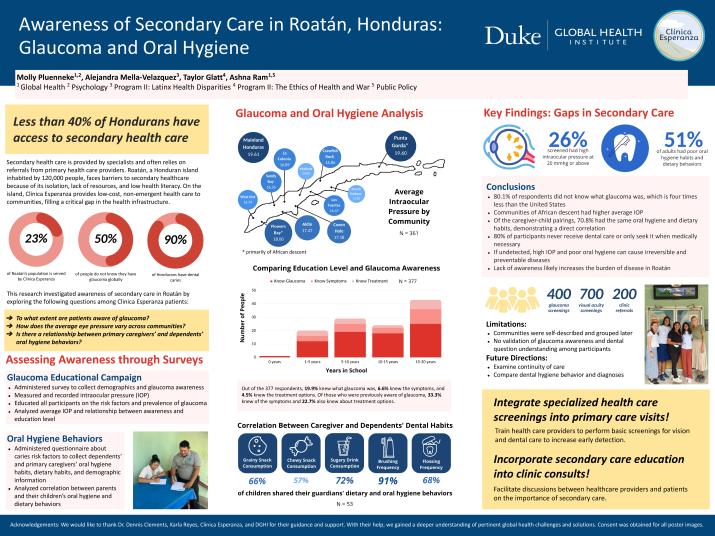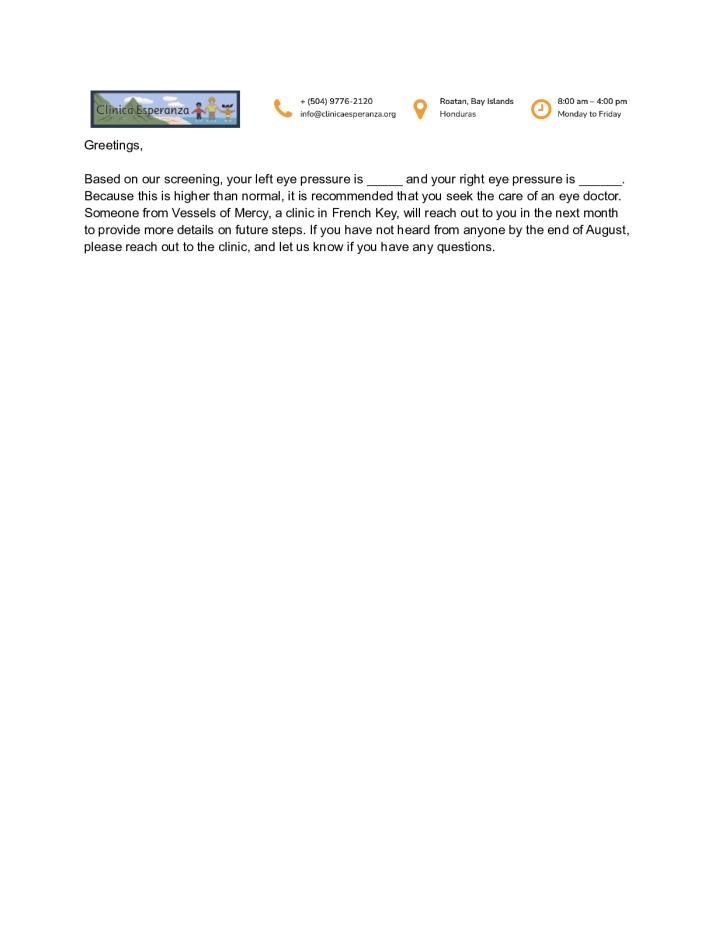Awareness of Secondary Care in Roatán, Honduras: Glaucoma and Oral Hygiene

Project member(s):
-
Molly Pluenneke
Alejandra Mella-Velazquez
Taylor Glatt
Ashna Ram
Faculty mentor:
Community partners:
-
Clinica Esperanza
Karla Reyes
Peggy Stranges
- Feedback? Contact the team
Awareness of Secondary Care in Roatán, Honduras: Glaucoma and Oral Hygiene
Project overview
Background
Located 32 miles off the coast of mainland Honduras, Roatán is a tropical island inhabited by 120,000 people. In Honduras, one in five people live in extreme poverty, and many lack access to health care. While 88.3% of Hondurans are covered by the Ministry of Health, this care is concentrated in densely populated urban centers, leaving rural areas with inadequate medical coverage.
Secondary health care is provided by specialists and often relies on referrals from primary health care providers. Because it is often overlooked in primary health care settings, it is not perceived as a priority and thus neglected in an individual’s overall health. While around 60% of Hondurans have access to primary care, less than 40% have access to secondary care.
With limited access to primary health care and low referral rates, patients are not only unable to obtain secondary care, but are also largely unaware of its importance. In an effort to increase accessibility to health care and address social determinants of health, Honduras’ Ministry of Health created a National Health Plan in 2010 to create a uniform, comprehensive health care model. However, as of 2017, there were only 0.3 physicians for every 1,000 patients, most of which were concentrated in urban areas.
Research Objectives and Methods
To address the importance of specialized health care literacy, this research investigated awareness of secondary care in Roatán, Honduras by partnering with Clinica Esperanza, who reaches 23% of Roatan’s residents. The following questions were explored among Clinica Esperanza patients:
- To what extent are adults aware of glaucoma?
- How does the average intraocular pressure vary across communities?
- Is there a relationship between primary caregivers’ and dependents’ oral hygiene behaviors?
Data Collection
The following methodologies were used for this research study:
- Glaucoma Awareness Survey: A Qualtrics survey was created to collect information on each adult participant’s age, community location in Roatán, sex, education level, and awareness of glaucoma’s symptoms and treatment options.
- Glaucoma Screenings: An iCare IC100Ⓡ tonometer device was used to measure adult patients' IOP and screen for glaucoma. Participants were then educated about what glaucoma is and the symptoms/treatment options.
- Oral Hygiene Habit Survey: To collect data on behaviors of oral hygiene and dietary habits, a caries risk questionnaire titled “Predicting Caries Risk in Underserved Children, from Toddlers to the School-Age Years, in Primary health care Settings” was adapted from Fontana M, Eckert GJ, Keels MA, et al. and administered to primary caregivers. The survey asked questions regarding the dependents’ and primary caregivers’ oral hygiene habits, dietary habits, and demographic information.
- Clinic Referrals: A Snellen chart and cover test were used in schools across Roatán, and those in need of refractive correction or amploybia (lazy eye) treatment were referred to the clinic. A list of adults with high IOP, over 20 mmhg, was compiled and given to the clinic for follow-up. Adults who expressed other vision-related complaints were also referred.
Discussion
Integration of secondary care into primary visits is a highly effective disease management and preventative care tool. This is especially relevant for LMICs like Honduras that have limited access to specialized care. Incorporating basic eye screenings, such as the Snellen Test and IOP checks, into primary health care settings can increase early detection of vision impairment and eye diseases. Similarly, by gathering patient information on dietary and oral hygiene habits, health care providers can identify caries risk factors. With these early prevention measures, providers can increase secondary care referrals into their practice and facilitate conversations on the importance of specialized care. This greater understanding of secondary care services contributes to a patient’s overall wellbeing.
Primary care providers should educate their patients about eye health during clinical visits to improve early detection and treatment adherence. Greater awareness of glaucoma, specifically of its asymptomatic nature and permanent consequences, increases the likelihood of patients seeking screenings and care. This is particularly important in the Roatán context because of the positive correlation between years in school and glaucoma awareness. The population had an average education level of 5-10 years, making specialized health care discussions between primary care physicians and their patients even more crucial. Moreover, patients are more likely to adhere to their glaucoma medication when they can recall conversations with their primary care physician about its importance.
A caregiver’s oral hygiene and dietary behaviors heavily influence their dependent’s habits. The direct correlation between adult and dependent behaviors emphasizes the need for education in primary care settings about the relationship between sugary foods/drinks and dental caries to encourage healthier dietary habits. Moreover, because 80% participants never receive dental care or only seek it when medically necessary, it is essential to emphasize the importance of dental care during primary care visits.
It is important to note that integrating secondary care into primary care visits requires a collaborative effort from all health care professionals involved. Potential barriers for secondary care integration include conflicts of interest, resource limitations, and poor internal communication. Additionally, primary care providers must be cognizant of their limitations in their medical expertise of specialized care to ensure ethical and quality care. Integration processes are most effective when providers establish shared goals and monitor care quality and performance for patients.
Project notes
Future research can examine the continuity of care for those identified with high IOP and assess the impact of the educational campaign on glaucoma awareness. To further research on oral hygiene behaviors, the relationship between oral hygiene habits and diagnoses can be analyzed. These results can help health care providers identify gaps in secondary care and improve early detection of glaucoma and dental caries.
As a team interested in various sectors of health care, we have gained unique perspectives on the value and challenges of global health fieldwork. Namely, we have seen the importance of approaching cross-cultural environments with empathy, open-mindedness, and enthusiasm. Our diverse backgrounds prepared us well to connect with different communities across the island, each of which had their own needs and resources. Discussions with participants illustrated the barriers many encounter in accessing health care, such as working during clinic hours, limited transportation options, and financial strains. Through these conversations, we gained a deeper understanding of Roatan’s health care context and the critical need for expanded infrastructure. The challenges we encountered, such as ensuring continuity of care and our lack of medical expertise, taught us how to adapt to our environments, utilize the resources available to us, and work alongside Honduran health care workers to provide ethical and quality care. As undergraduate students, we deeply appreciate the guidance and insights provided by our community partners. Thank you, Clinica Esperanza!
Media and resources

Last updated on June 26, 2023





